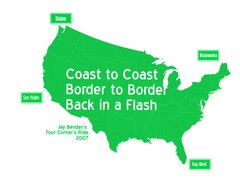



The question most frequently asked of me during and after the trip, "Did you go with anyone, or were you alone?"
With the exception of the times I rode with Mary and Ken from Seattle to Blaine and back and with Todd through the mountains west of the Hudson Valley, I didn't ride with anyone else on a motorcycle. I wasn't alone, though.
When I was getting ready to take my Alaska trip Jack Wiggers, one of my grandchildren, made a pet rock for me. We mounted the rock to the tachometer glass with hook and loop closure material (you and I call it Velcro, a trademarked brand). With the exception of the roughest sections of the Dalton Highway between Cold Foot and Prudhoe Bay, the pet rock rode on the tach. On those rough sections it rode in the tank bag.
On this trip the rock rode the entire distance on the tach. So, I wasn't alone because I always had my pet rock with me.
And even though my family and friends weren't along on the ride most of the time, I knew of their interest and attention. Todd and Mary worked harder on the blog than I did, and Ray monitored the AeroAstro tracking site closely when he wasn't on the golf course. Kim Irving of AeroAstro sent me a note yesterday to let me know that the tracking site had more than 2,000 hits from more than 200 discrete computers over the course of the ride. Ray could only account for two or three computers and no more than half the hits, so I had lots of eyes on my progress. Thank you. I knew you were with me.
The one person who was most involved with me on the trip was my wife Anne who is shown in our kitchen. Anne has ridden on a couple of cross country motorcycle trips, and met me for an Alaska Ferry cruise on the way back from Prudhoe Bay. We've talked about a trike conversion of a Gold Wing or a BMW cruiser to increase her comfort level on future rides. Anne says most of what she has seen on these trips has been the back of my helmet. I've suggested a sidecar to improve the view, but that idea doesn't have any traction.
My route didn't take me through Atlanta this trip so I don't have any new pictures of my stepdaughter Liz, her husband John Mark Wiggers and their two boys Jack (creator of the pet rock) and Elliott, who was born after the Alaska trip. All but Elliott are pictured in the Alaska blog.
I have included photos of the rest of the Columbia cast. My daughter Sumner is shown on the evening we celebrated a numerically significant birthday (divisible by five). Sumner is shown with her friend Adam Wamer, who, like Sumner, is in the final stages of his undergraduate studies at the University of South Carolina.
My younger son, Edward, is shown with his wife Tracy. Edward is in his first year of law practice with Nexsen Pruet LLC in Columbia assigned to the firm's health care team. Tracy is public relations director for the innovative and successful charity Souper Bowl of Caring. Souper Bowl organizes churches around the country to get youth groups involved on the Sunday the National Football League plays its Super Bowl. The youth groups raise money for charities in their communities. One distinguishing characteristic of Souper Bowl is that none of the money raised in the communities goes to support the national organization, but is put to use in the communities where it is raised for purposes chosen by local participants.
Tracy's parents, Gary and Dottie Bonds, are in the construction equipment rental business north of Atlanta, but still find time to get out and about on Gary's Harley. Gary has completed some Iron Butt adventures and ridden to Alaska.
Friends, colleagues and clients have all said they're glad I'm home. I appreciate their thoughts and expressions. I'm also glad to be back home.
I'm glad you were along for the ride. I'll think of another adventure down the road, and invite you to come along. That way I won't have to travel alone.








